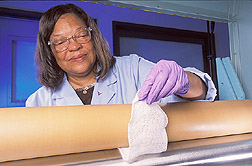This page has been archived and is being provided for reference purposes only. The page is no longer being updated, and therefore, links on the page may be invalid.
|
Read the magazine story to find out more. |
Researchers Develop "Smart" Wound DressingBy Amy SpillmanJanuary 10, 2003 Cotton gauze has been used to dress wounds for hundreds of years because it is naturally soft, pliable and absorbent. Now, a scientist from the Agricultural Research Service and his collaborators are using modern technology to further improve this cotton product and add to its list of beneficial characteristics. For several years, Vince Edwards, a chemist in the Cotton Textile Chemistry Research Unit at ARS' Southern Regional Research Center in New Orleans, La., has been working with scientists from the Medical College of Virginia (MCV) at Virginia Commonwealth University in Richmond. In 1999, they developed a way to chemically modify cotton gauze so that it selectively targets and soaks up elastase--an enzyme that breaks down connective tissue proteins that are essential to proper wound healing. Elastase exists at elevated levels in bed sores, diabetic foot sores and other wounds that won't heal. Although occlusive dressings, which limit water vapor loss and promote moist wound environments, have become a viable option, cotton gauze remains the standard dressing material for wound care in nursing homes and hospitals. Edwards and his collaborators have conducted laboratory tests on their chemically modified cotton dressings and achieved positive results. They hope to test these "smart" dressings on chronic wound patients in the near future. Tissue Technologies, a company based in Richmond, Va., has licensed the technology. In 2002, it received a phase-one grant from the National Institutes of Health through the Small Business Innovation Research program. The company has applied for phase-two funding--$1 million--which would be enough to pay for a clinical trial. Every year, about one million Americans develop chronic wounds or pressure ulcers, which result in patient care costs approaching $750 million. The modified gauze that Edwards and his collaborators developed is simple and inexpensive to manufacture. It may ultimately be used in hospitals and nursing homes. Read more about Edwards' research, including his role in developing a new kind of occlusive dressing for burns, in the January issue of Agricultural Research magazine. ARS is the U.S. Department of Agriculture's chief scientific research agency. |

